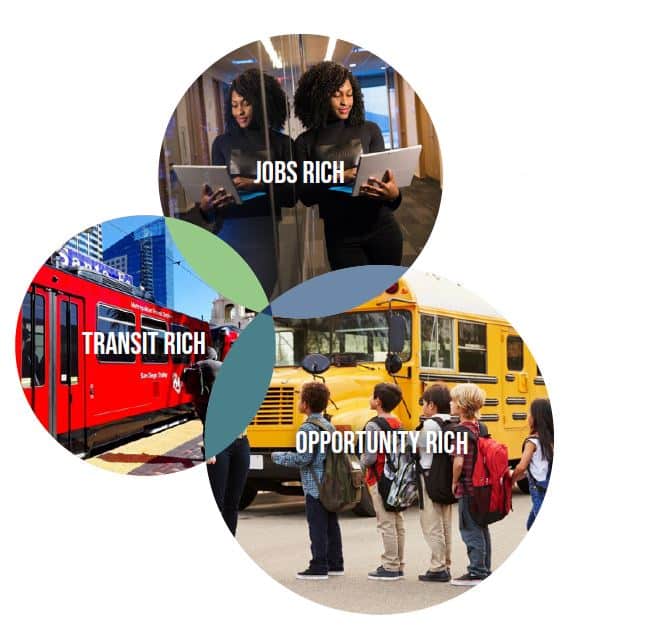Reading time: 5 minutes
As I have written about in the past, the government has played a crucial, often intentional, role in creating a housing market that incentivizes exclusion. During this time, incremental housing and land use policy choices at every level of government have accumulated into a discriminatory system in which complex webs of laws and regulations make the production of housing needlessly restrictive and prohibitively expensive.
Creating more affordable and attainable housing options is key to unlocking opportunities for millions of families. We believe that policymakers working to eliminate those barriers today should prioritize bringing a racial equity lens to that work. Policymakers must actively reverse our history of exclusionary policies and advance policies instead that create Accessible Growth.
Enabling housing in neighborhoods that have these characteristics can unlock access to opportunity and create a more resilient, just, and equitable future.

Opportunity Rich Neighborhoods
Accessible Growth recognizes that place-based interventions are models for expanding opportunity and equity to marginalized communities.
Groundbreaking research from Harvard University’s Opportunity Insights group, presented in the Opportunity Atlas, quantitatively measures upward mobility at the census tract level. Using a wide range of data – incarceration rates, employment, poverty, income level, and educational attainment, among others – the Opportunity Atlas demonstrates that the neighborhood in which a person grows up has the most significant impact on life outcomes.
The idea that where you live is a significant factor in your prospects for future success may seem intuitive. However, the granularity and peer-acceptance of the research mean the Opportunity Atlas is a must-use tool for policymakers and housing advocates. Outcomes for children who grow up a couple of miles or even a few blocks from each other vary significantly based on these factors.
Transportation and Infrastructure Rich Neighborhoods
Accessible Growth leverages existing infrastructure investments to achieve economic resilience and inclusive economic growth.
In addition to the quality of life benefits, connecting housing with existing transportation and infrastructure positively impacts the environment: fewer cars on the road, reduced sprawl, and decreased greenhouse gas emissions. Prioritizing housing opportunities near transit, town squares, and walkable communities are proven to attract knowledge-based employment while reducing transportation costs for low- and middle-income households.
Policy recommendations within our Housing Underproduction in the U.S. report reflect this priority, as does specifically Up for Growth Action-supported signature legislation such as the Build More Housing Near Transit Act.
Job Rich Neighborhoods
Accessible Growth incentivizes job-rich but often housing-poor areas to build more housing, especially affordable and workforce housing.
Some of the fastest-growing job centers in the country are already experiencing a housing shortage and affordability crisis. It is necessary to tackle this imbalance to unlock these communities’ full economic potential. Moreover, the COVID pandemic has dramatically shown the need for affordable and attainable housing in high-opportunity places. Front-line workers, health care providers, school teachers and public safety officers need affordable and attainable housing close to where they work.
Addressing the jobs-to-housing imbalance will make our economy much more resilient, protecting vital services in high opportunity places while being more just and fair.

Neighborhoods with these characteristics are more common and geographically diverse than you might think. Approximately 23% of all neighborhoods across the U.S. have at least one of these characteristics. Surprisingly, these neighborhoods can be found across a diverse range of places, from exclusively urban to predominantly rural. Some are in stereotypically suburban enclaves, while many are somewhere in the middle. Indeed, every community has neighborhoods that can be tapped to drive Accessible Growth.
For example, one type of neighborhood that can drive Accessible Growth is located in the heart of Boston, encompassing part of the city’s Chinatown. You can also find high opportunity, transportation and infrastructure-rich, and job-rich neighborhoods in the inner suburbs of Atlanta, suburban St. Louis County, the exurbs of Dallas-Fort Worth, and in Hillsboro, Oregon, in metro Portland. Even small towns like Morgantown, West Virginia, and Bowling Green, Kentucky, have places they can leverage to drive Accessible Growth, transforming access to opportunity, infrastructure, and plentiful jobs for its citizens.
Accessible Growth prioritizes and incentivizes building housing for people of all income levels in places where housing will have the most impact. The long-term goal is for more Americans to live in places that lead to better outcomes for themselves and their children. Smart housing policy that advances Accessible Growth can help get us there.
